Lưu ý bảo quản Original Calibration Sheet khi sử dụng thiết bị kiểm tra mã vạch
01-03-2017, 10:13 amThiết bị kiểm tra mã vạch - barcode verifier là thiết bị kỹ thuật cao sử dụng công nghệ thấu kính quang học chuyên cho mục đích kiểm định đánh giá chất lượng mã vạch in ra. Thiết bị này đòi hỏi phải được hiệu chỉnh (calibrate) trước khi đưa vào sử dụng và được test hiệu chỉnh hàng năm hoặc đưa trở lại nhà máy sản xuất để kiểm tra hiệu chỉnh lại toàn bộ sau một khoảng thời gian sử dụng tùy vào mỗi quy định của từng Hãng.
Mỗi thiết bị kiểm tra mã vạch sẽ được đi kèm với 1 tờ Clabration Card bản gốc tiêu chuẩn từ Hãng. Calibration card không sử dụng được khi sao chụp lại hoặc có hiện tượng rách, cũ... Nếu không có calibration Card sẽ không sử dụng được thiết bị kiểm tra mã vạch Hoặc sau thời gian quy định của hãng mà không test calibration lại thì kết quả kiểm tra cũng không tin cậy nữa. Chính vì tầm quan trọng của tờ Calibration Card đối với thiết bị kiểm tra mã vạch kể trên, Smartid xin khuyến cáo khách hàng khi mua mới phải test xem có thiết bị calibration card tiêu chuẩn kèm theo hay không, trong quá trình sử dụng cũng phải cất giữ và bảo quản cẩn thận, không được làm mất hay hư hại.
Một số mẫu calibration Card của các hãng RJS, Axicon, Stratix, Webscan...
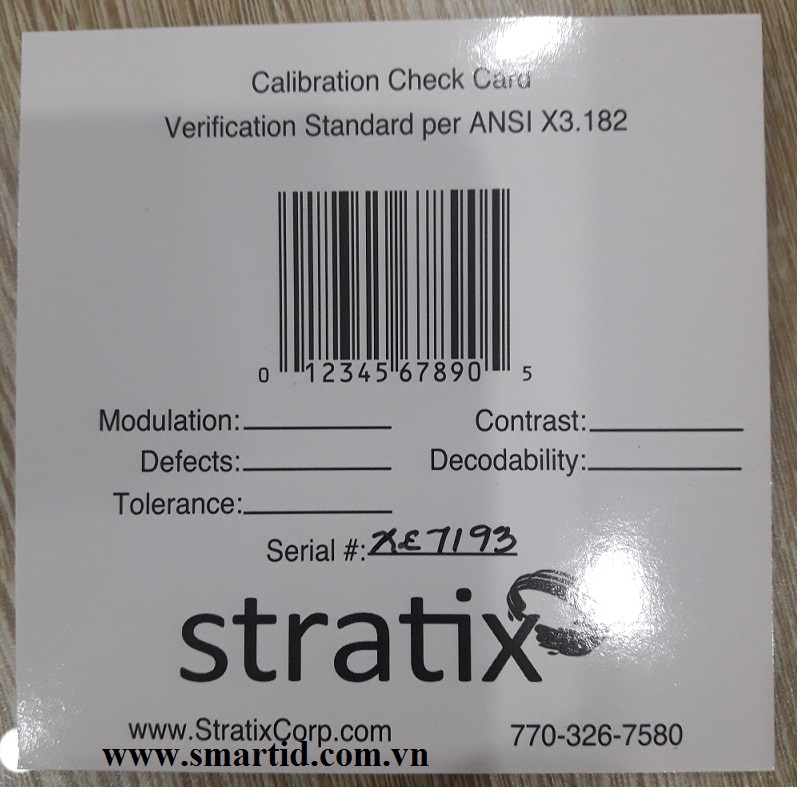
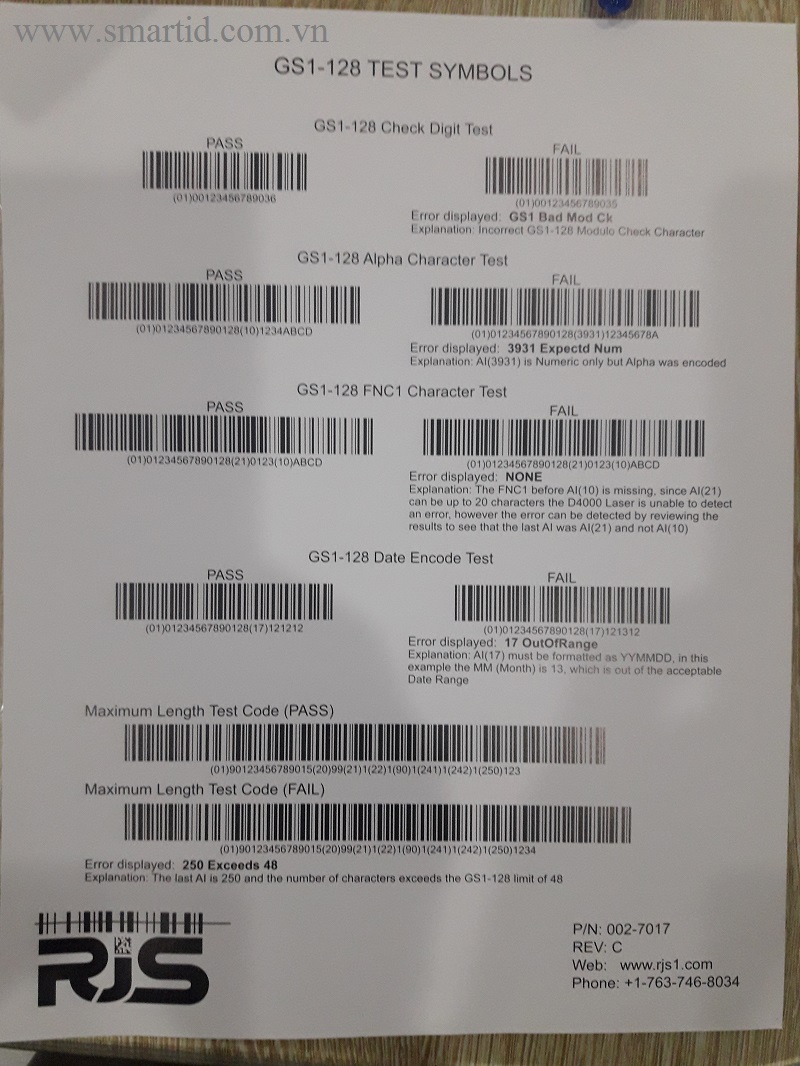
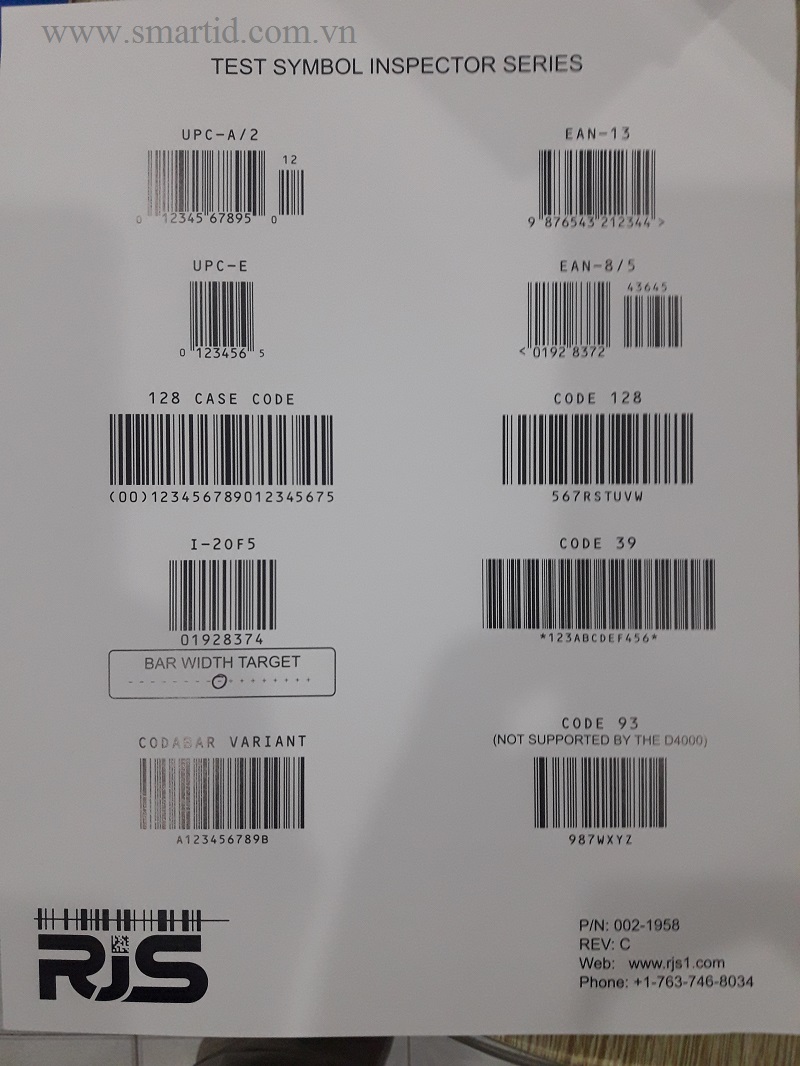
Mời quý vị tham khảo tài liệu cụ thể hơn về Calibration Card:
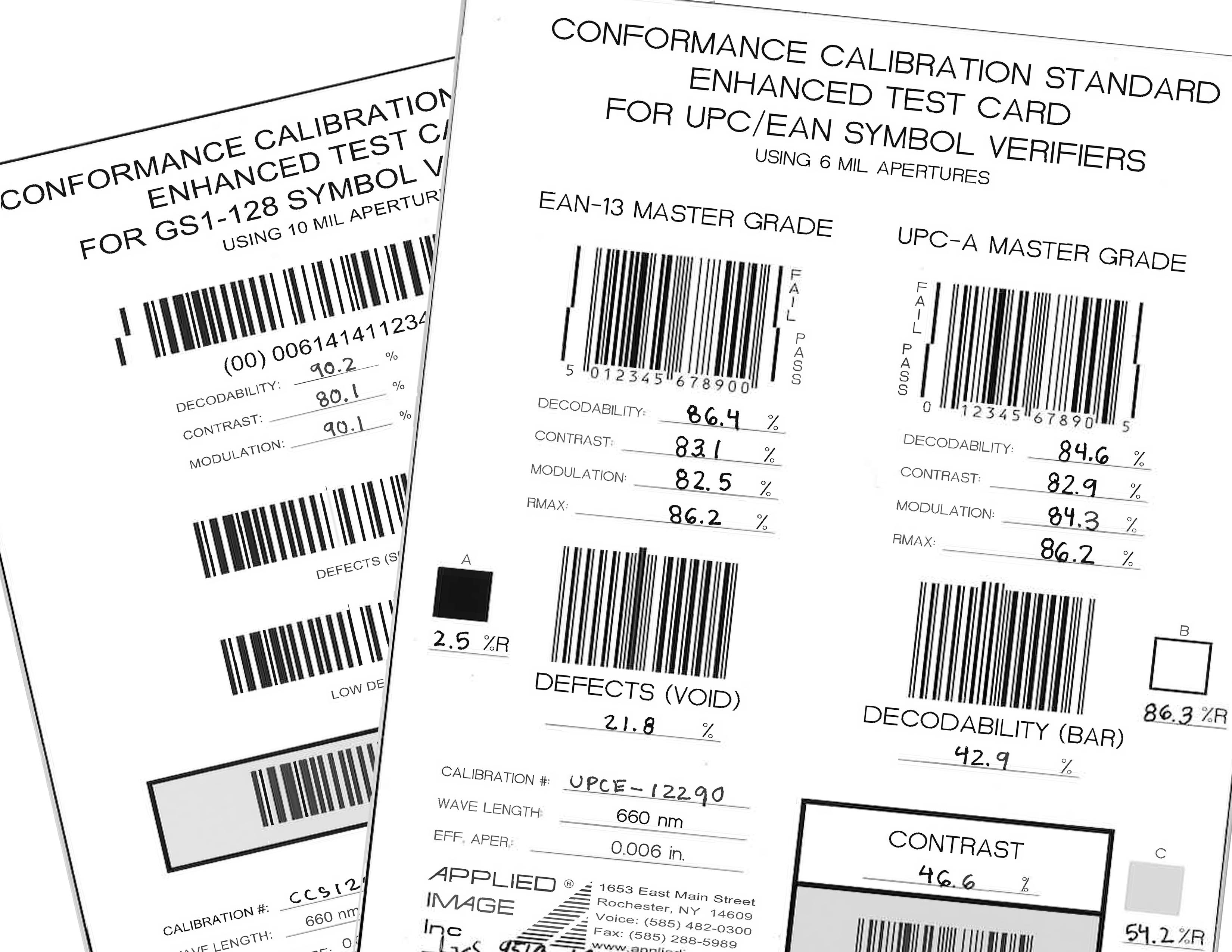
Accurate verification and readability of barcodes is essential in avoiding fines, rejects, noncompliance, and other errors that could result in lost productivity and profits. With so much on the line, how can you ensure that your verifier complies with GS1, ISO, and IEC standards? Cue the Calibration Card.
What Is Calibration?
Calibration in measurement technology and metrology is the comparison of measurement values delivered by a device under test with those of a calibration standard of known accuracy. Such a standard could be another measurement device of known accuracy, a device generating the quantity to be measured. The outcome of the comparison can result in:
No significant error being noted on the device under test
A significant error being noted but not adjustment made
An adjustment made to correct the error to an acceptable level.
Strictly speaking, the term calibration means just the act of comparison, and does not include any subsequent adjustment.
What Is a Calibration Card?
A calibration card is a test card printed with blemishes and defective symbols to test your verifier. It is engineered to challenge your verifier’s conformance to various standards. Your verifier’s results must match the documented flaws on the card within a specific tolerance in order to demonstrate compliance. Barcode verification systems are designed to identify all common readability issues, but also to grade codes against specific thresholds of acceptable quality for each readability parameter. A calibration card determines whether your barcode verification system is either compliant or non-compliant.
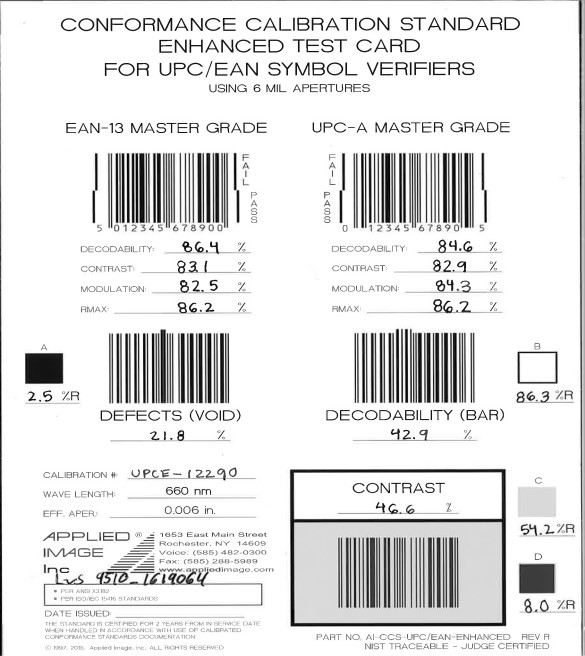

All of the certification documents are included with the card including the Calibration Certificate
Why Calibration Cards Are Important
Calibration cards are necessary to certify that your verification system conforms with specific standards, qualifying it to verify symbols in your application. All calibration cards are created in a rigorously controlled environment, and the calibration cards are themselves verified to ISO/IEC standards by a master verifier. Without a valid calibration card, your verification system could be out of compliance, creating rejects, errors, brand degradation, and other costly failures.
Days before calibration needed
It is important to calibrate the system over a period of time. This feature sets up the desired number of days between system calibration. When the period of time has been reached, the software will not allow you to continue until calibration has been completed.
The frequency will be determined by Customers on how often they calibrate, however, when an agreed time for calibration is determined, the administrator will enter the value EX: Every 30 days in the field for days before calibration needed on the setup tab. Once populated, the software will notify operators when calibration is due, and will not allow them to proceed until a valid calibration has been performed.
There are situations that you may want to perform a calibration on the system other than the standard days before calibration which may include:
A new instrument
After an instrument has been repaired or modified
When a specified time period has elapsed
When a specified usage (operating hours) has elapsed
After an event, for example
After an instrument has been exposed to a shock, vibration, or physical damage, which might potentially have compromised the integrity of its calibration
Whenever observations appear questionable or instrument indications do not match the output of surrogate instruments
As specified by a requirement, e.g., customer specification, instrument manufacturer recommendation.
In general use, calibration is often regarded as including the process of adjusting the output or indication on a measurement instrument to agree with value of the applied standard, within a specified accuracy.
Do Calibration Cards Expire?
Yes, they do! A calibration card is certified for two or one years. Documentation highlighting the calibration card expiration date is provided upon receipt of the card. So, for example, if you received your calibration card in November 2014, your card is now expired or about to expire.
Chi tiết về thiết bị kiểm tra mã vạch và Calibration Card cũng như về dịch vụ hiệu chỉnh toàn bộ thiết bị, vui lòng liên hệ với chúng tôi.
- Các thiết bị và giải pháp RFID phù hợp cho chuỗi bán lẻ của người Việt
- So sánh thông số kỹ thuật và hiệu năng của đầu đọc UHF Impinj R420 và R700
- Một số thiết bị hạ tầng kỹ thuật cho triển khai Bệnh án điện tử
- Kiosk tự phục vụ tích hợp đọc Căn cước công dân (CCCD), bằng lái xe và xác thực khuôn mặt
- Các module cho ứng dụng Fin-tech, không tiền mặt, nhận dạng thông minh chuyên cho ATM, Kiosk, AFC...
- So sánh tính năng 2 bộ điều khiển cột bơm xăng dầu SPG
- Hệ thống cổng phân làn kiểm soát ra vào bằng khuôn mặt cho trường học
- Thiết bị xác thực căn cước công dân gắn chip có tem chứng nhận RAR (C06)
- Tư vấn lựa chọn ăng ten RFID UHF cho hệ thống cổng đọc xuất nhập hàng
- Lựa chọn cổng phân làn flap barrier cho giao thông công cộng, khu vui chơi quy mô lớn
- So sánh module thiết bị đọc vân tay DigitalPersona
- Bổ sung thêm về so sánh tính năng của thiết bị kiểm tra mã vạch RJS 4000L và D4000A
- Tư vấn cách chọn máy chấm công ACTAtek
- Giới thiệu đầu đọc thẻ tầm xa RFID 433Mhz Pegasus cho hệ thống car parking
- Thiết bị đọc thẻ UHF cầm tay chuyên dụng cho ứng dụng đọc thẻ RFID
- So sánh thẻ Mifare Ultralight, Mifare classic và Mifare plus S 2K
- Thiết bị RFID Handheld cầm tay chuyên cho dự án
- So sánh tính năng,bảo mật, ứng dụng của thẻ Mifare Classic, Mifare Plus, Mifare DESFire
- Giải pháp dùng đầu đọc RFID 433Mhz cho quản lý ra vào nhiều loại phương tiện
- Lưu ý lắp đặt đầu đọc UHF cho hệ thống quản lý xe ô tô - car parking


